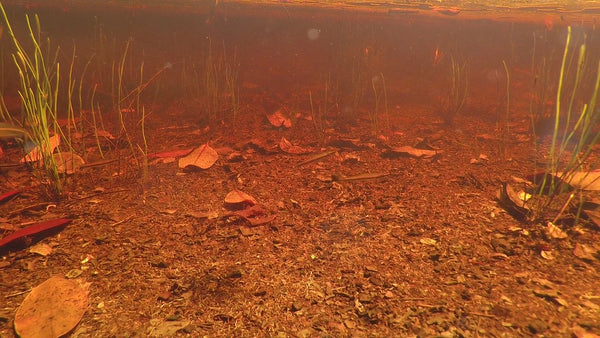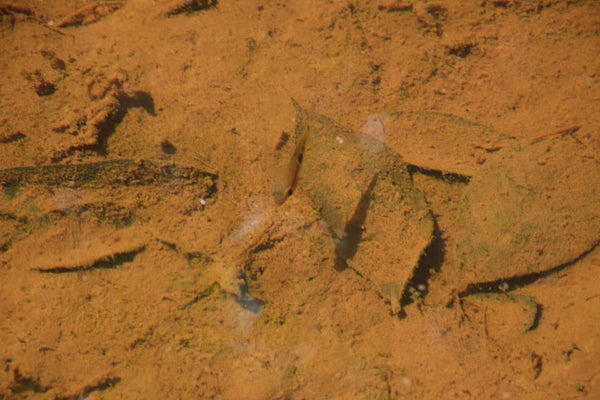- Continue Shopping
- Your Cart is Empty
Building a microcosm. Starting from the bottom...
As you know by now, we're completely obsessed with how diverse aquatic ecosystems arise, function, and sustain themselves, and how we can interpret this for application to our aquarium work.
It's a lot more interesting, when you examine the subject more closely- especially from the perspective of how these aquatic habitats came to be, and what implications they have for fish populations...cool stuff.

And so much of what makes these ecosystems operate so successfully starts with the bottom!
Stream and river bottom composition is affected by things like regional weather, current, geology, the surrounding dry lands, and a host of other factors- all of which could make planning your next aquarium even more interesting if you take them into consideration!

We've touched on these in some recent posts, and we'll definitely dive deeper in upcoming blogs. There's more to this type of aquarium just the accumulation of leaves and such.
It's pretty interesting...

If we focus on shallow tributaries of streams and flooded forest floors, which are one my personal areas of interest, it's important to note that the volume of water entering the stream, helps in part determine the amount and size of sediment particles, leaves, beaches, seed pods, and the like that can be carried along, and thus comprise the substrate and it's contours. The mixing of materials not only looks interesting- it's a reflection of the diversity and vibrancy of the underwater environment.

One of the things you notice in the images above of natural underwater substrates is that they're usually anything but squeaky-clean, ultra-white sand. Rather, they're often sediment-filled, covered with stringy fungal growths, biofilms, and even a spot or two of algae. There is a fair amount of detritus accumulating in the substrate materials. And, as you know, detritus is not the enemy that we've made it out to be. Rather, it's a source of food for many aquatic animals, helping to literally "power" the ecosystem in which they are present.
This is something we can-and should- absolutely replicate in our aquariums. Don't be afraid of sediments and even detritus accumulating on top of your leaves and botanicals...it's exactly what you see in Nature, and our fishes are ecologically adapted to such habitats.

In Nature, the composition of bottom materials and the depth of the channel are always changing in response to the flow in a given stream, affecting the composition and ecology in many ways. Some of these changes are actually the result of the fishes "working them."
In the words of our friend, author Mike Tuccinardi:
"One of the things that is most striking when you spend time below the water’s surface in this sort of environment is that the fish aren’t just passive inhabitants—they’re actively involved with their habitat, interacting in a very particular way. Apistogramma species aren’t just hanging out, they’re fighting turf wars among piles of dense leaf litter, even making their own piles by moving leaves and other bits of detritus to the center of their territories.
Suckermouth catfish, whether Farlowella or Ancistrus, are actively exploring recently-submerged branches and roots, looking for a rich patch of biofilm or algae to feast on. Eartheaters and many other species of cichlids—even Severums, Angelfish, and Discus—are patrolling the bottom, taking big mouthfuls of sand and organic material to sift out any tasty morsels. It’s a big, organic mess, literally made up of various botanicals and these fish are having a field day in it."

These dynamic habitats are not difficult to replicate in the aquarium. We need to understand that they play a functional and aesthetic role in the overall aquarium, as we've touched on many times here. Realizing that placing leaves and botanical materials on the bottom of the aquarium is not simply making an aesthetic statement. Rather, it's an homage to the function of the dynamic habitats we love so much.

Feeding dynamics play a huge role in the interactions which fishes have with the bottom. As we've talked about previously, aquatic invertebrates and crustaceans are one of the primary foods consumed by many fishes which reside in tropical streams, and the amounts and types are dictated by the environment of the stream, which includes factors like the surrounding topography, current, elevation, surrounding plant growth, etc.
Many fishes, like Headstanders, characins, and others, simply consume tiny crustaceans as part of their sediment feeding activity. Now that we're more likely to set up aquariums with fine, silty sediments stocked with tons of little copepods and worms and such, these experiments may yield very interesting results!

It is absolutely possible to create a real "active substrate", filled with these creatures, and to be able to "pre-stock' it with cultures of small life forms prior to the introduction of fish! And of course, there are ways to replenish the population of these creatures (and even the substrate itself) periodically, resulting in extremely productive systems, too!
An interesting experiment to think about, huh? Even more interesting to actually execute. Could such a system, with a heavy "substrate-centric" focus be successfully managed long-term?

For sure.
A well-managed substrate, in which uneaten food and fish feces are not allowed to accumulate to excess, and in which regular nutrient export processes are embraced, it's not an issue, IMHO. When other good practices of aquarium husbandry (ie; not overcrowding, overfeeding, etc.) are empIoyed, a botanically-"enriched" substrate can enhance- not inhibit- the nutrient processing within your aquarium and maintain water quality for extended periods of time.
Like many of you, I have always been a firm believer in some forms of nutrient export being employed in every single tank I maintain. Typically, it's regular water exchanges. Not "when I think about it', or "periodically", mind you.
Nope, it's weekly.
Now I'm not saying that you can essentially disobey all the common sense husbandry practices we've come to know and love in the hobby (like not overcrowding/overfeeding, etc.) and just change the water weekly and everything's good.
And I'm not suggesting that the only way to succeed with adding botanical materials to the substrate is to employ massive effort at nutrient export; the system otherwise teetering on a knife's edge, with disaster on one side and success on the other.
Nope.
Our aquariums are far more resilient than that. If we set them up to be. And that means "configuring" them to be successful, diverse, biologically-rich ecosystems at all levels.
There is a lot of science to sift through about natural river/stream/pond substrates and how they function in the wild, and much of this can be applied to what we do in our closed aquariums. Of course, an aquarium is NOT a stream, river, etc. However, the same processes and "rules" imposed by Nature that govern the function of these wild ecosystems apply to our little glass and acrylic boxes.
It's a matter of nuance and attempting to understand how they work.

My goal is to keep us in the mindset of thinking about our aquariums as little "microcosms", not just "aquatic dioramas."
This is what will continue to move the hobby forward, IMHO.
And of course, the whole idea of a rich, sediment-sand-and-soil substrate enriched with botanical materials is completely in line with the "best practices" we've developed as a community to create dynamic, botanical-style aquariums. In our case, not only will there be an abundance of trace elements and essential plant nutrients be present in such a substrate, there will be the addition of tannins and humic substances which provide many known benefits for fishes as well.
The best of both worlds, I think!

It's time to really dig deep into the art and science of creating an entire ecosystem in the confines of our aquariums!
I can't think of anything more exciting than that!
Stay excited. Stay inspired. Stay resourceful. Stay educated...
And Stay Wet.
Scott Fellman
Tannin Aquatics







Scott Fellman
Author